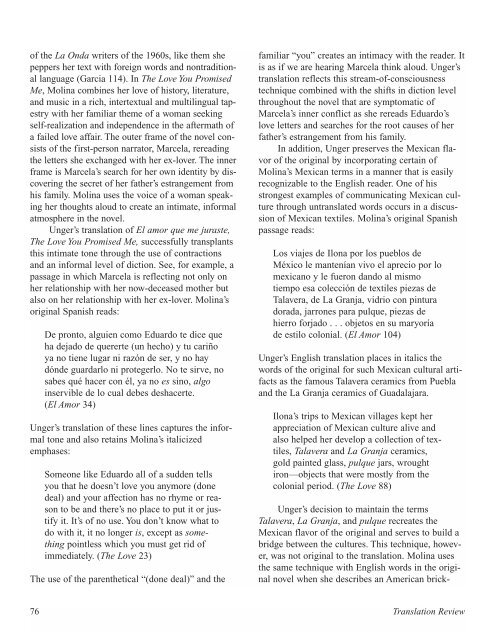Translation Review - The University of Texas at Dallas
Translation Review - The University of Texas at Dallas
Translation Review - The University of Texas at Dallas
Create successful ePaper yourself
Turn your PDF publications into a flip-book with our unique Google optimized e-Paper software.
<strong>of</strong> the La Onda writers <strong>of</strong> the 1960s, like them she<br />
peppers her text with foreign words and nontraditional<br />
language (Garcia 114). In <strong>The</strong> Love You Promised<br />
Me, Molina combines her love <strong>of</strong> history, liter<strong>at</strong>ure,<br />
and music in a rich, intertextual and multilingual tapestry<br />
with her familiar theme <strong>of</strong> a woman seeking<br />
self-realiz<strong>at</strong>ion and independence in the afterm<strong>at</strong>h <strong>of</strong><br />
a failed love affair. <strong>The</strong> outer frame <strong>of</strong> the novel consists<br />
<strong>of</strong> the first-person narr<strong>at</strong>or, Marcela, rereading<br />
the letters she exchanged with her ex-lover. <strong>The</strong> inner<br />
frame is Marcela’s search for her own identity by discovering<br />
the secret <strong>of</strong> her f<strong>at</strong>her’s estrangement from<br />
his family. Molina uses the voice <strong>of</strong> a woman speaking<br />
her thoughts aloud to cre<strong>at</strong>e an intim<strong>at</strong>e, informal<br />
<strong>at</strong>mosphere in the novel.<br />
Unger’s transl<strong>at</strong>ion <strong>of</strong> El amor que me juraste,<br />
<strong>The</strong> Love You Promised Me, successfully transplants<br />
this intim<strong>at</strong>e tone through the use <strong>of</strong> contractions<br />
and an informal level <strong>of</strong> diction. See, for example, a<br />
passage in which Marcela is reflecting not only on<br />
her rel<strong>at</strong>ionship with her now-deceased mother but<br />
also on her rel<strong>at</strong>ionship with her ex-lover. Molina’s<br />
original Spanish reads:<br />
De pronto, alguien como Eduardo te dice que<br />
ha dejado de quererte (un hecho) y tu cariño<br />
ya no tiene lugar ni razón de ser, y no hay<br />
dónde guardarlo ni protegerlo. No te sirve, no<br />
sabes qué hacer con él, ya no es sino, algo<br />
inservible de lo cual debes deshacerte.<br />
(El Amor 34)<br />
Unger’s transl<strong>at</strong>ion <strong>of</strong> these lines captures the informal<br />
tone and also retains Molina’s italicized<br />
emphases:<br />
Someone like Eduardo all <strong>of</strong> a sudden tells<br />
you th<strong>at</strong> he doesn’t love you anymore (done<br />
deal) and your affection has no rhyme or reason<br />
to be and there’s no place to put it or justify<br />
it. It’s <strong>of</strong> no use. You don’t know wh<strong>at</strong> to<br />
do with it, it no longer is, except as something<br />
pointless which you must get rid <strong>of</strong><br />
immedi<strong>at</strong>ely. (<strong>The</strong> Love 23)<br />
<strong>The</strong> use <strong>of</strong> the parenthetical “(done deal)” and the<br />
familiar “you” cre<strong>at</strong>es an intimacy with the reader. It<br />
is as if we are hearing Marcela think aloud. Unger’s<br />
transl<strong>at</strong>ion reflects this stream-<strong>of</strong>-consciousness<br />
technique combined with the shifts in diction level<br />
throughout the novel th<strong>at</strong> are symptom<strong>at</strong>ic <strong>of</strong><br />
Marcela’s inner conflict as she rereads Eduardo’s<br />
love letters and searches for the root causes <strong>of</strong> her<br />
f<strong>at</strong>her’s estrangement from his family.<br />
In addition, Unger preserves the Mexican flavor<br />
<strong>of</strong> the original by incorpor<strong>at</strong>ing certain <strong>of</strong><br />
Molina’s Mexican terms in a manner th<strong>at</strong> is easily<br />
recognizable to the English reader. One <strong>of</strong> his<br />
strongest examples <strong>of</strong> communic<strong>at</strong>ing Mexican culture<br />
through untransl<strong>at</strong>ed words occurs in a discussion<br />
<strong>of</strong> Mexican textiles. Molina’s original Spanish<br />
passage reads:<br />
Los viajes de Ilona por los pueblos de<br />
México le mantenían vivo el aprecio por lo<br />
mexicano y le fueron dando al mismo<br />
tiempo esa colección de textiles piezas de<br />
Talavera, de La Granja, vidrio con pintura<br />
dorada, jarrones para pulque, piezas de<br />
hierro forjado . . . objetos en su maryoría<br />
de estilo colonial. (El Amor 104)<br />
Unger’s English transl<strong>at</strong>ion places in italics the<br />
words <strong>of</strong> the original for such Mexican cultural artifacts<br />
as the famous Talavera ceramics from Puebla<br />
and the La Granja ceramics <strong>of</strong> Guadalajara.<br />
Ilona’s trips to Mexican villages kept her<br />
appreci<strong>at</strong>ion <strong>of</strong> Mexican culture alive and<br />
also helped her develop a collection <strong>of</strong> textiles,<br />
Talavera and La Granja ceramics,<br />
gold painted glass, pulque jars, wrought<br />
iron—objects th<strong>at</strong> were mostly from the<br />
colonial period. (<strong>The</strong> Love 88)<br />
Unger’s decision to maintain the terms<br />
Talavera, La Granja, and pulque recre<strong>at</strong>es the<br />
Mexican flavor <strong>of</strong> the original and serves to build a<br />
bridge between the cultures. This technique, however,<br />
was not original to the transl<strong>at</strong>ion. Molina uses<br />
the same technique with English words in the original<br />
novel when she describes an American brick-<br />
76 <strong>Transl<strong>at</strong>ion</strong> <strong>Review</strong>

















